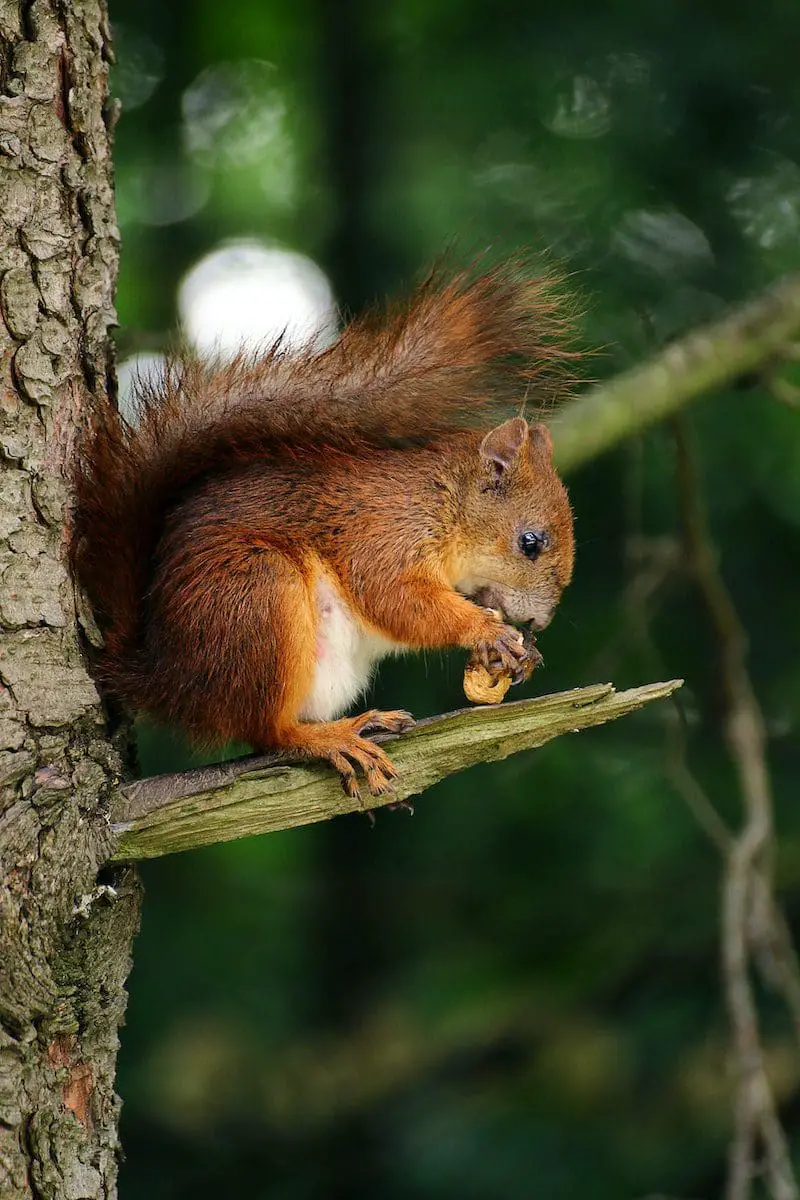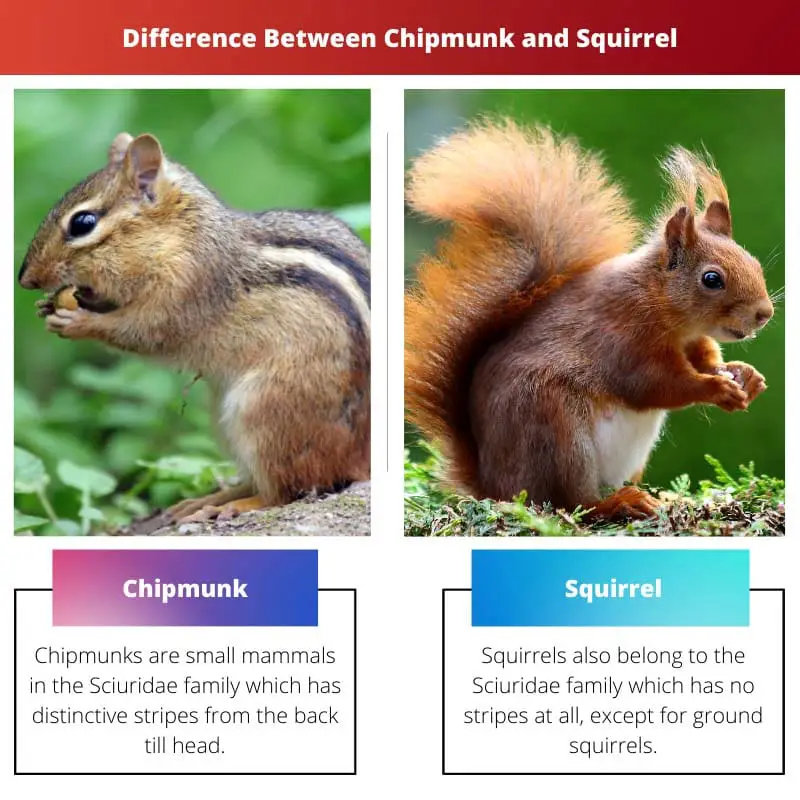Chipmunks, smaller and striped, dwell in burrows, storing food meticulously. Squirrels, larger and bushy-tailed, forage in trees, caching nuts widely. Both are agile, resourceful rodents, adapted to diverse habitats.
Key Takeaways
- Chipmunks are smaller than squirrels, with distinctive striped markings, while squirrels are larger and have solid-colored fur.
- Chipmunks primarily burrow in the ground, creating complex tunnels, while squirrels are arboreal, making nests in trees.
- Both chipmunks and squirrels are members of the Sciuridae family, but chipmunks belong to the genus Tamias, while squirrels belong to various genera, including Sciurus and Tamiasciurus.
Chipmunk vs Squirrel
Chipmunks are smaller, have stripes on their backs, and are known for their distinctive chipmunk calls. Squirrels are also small but do not have distinct stripes, except for the ground squirrel, which has stripes but not on the head. Squirrels also hoard food and are known for their intelligence, while chipmunks are more solitary and primarily gather food for their winter stores.

Comparison Table
| Feature | Chipmunk | Squirrel |
|---|---|---|
| Size | Smaller (8-10 inches long, 2-5 oz) | Larger (16-21 inches long, 1-1.5 lbs) |
| Tail | Shorter and bushier | Longer and bushier, used for balance and communication |
| Cheeks | Have cheek pouches for storing food | No cheek pouches |
| Habitat | Prefer forests, woodlands, and rocky areas | More adaptable, found in forests, parks, and even urban areas |
| Diet | Primarily herbivores (nuts, seeds, fruits) | Omnivores (nuts, seeds, fruits, insects, eggs) |
| Hibernation | True hibernation (sleep and wake periodically) | Winter dormancy (less active but stay awake) |
| Social behavior | Solitary except during breeding season | Can be more social, living in groups or pairs |
| Appearance | Brown fur with distinct black and white stripes on back and sides | Varied fur colors (gray, brown, red), no stripes |
| Distinctive features | Fast chirp vocalizations | More varied vocalizations, including chatters, barks, and squeaks |
What is Chipmunk?
Chipmunks are small, striped rodents belonging to the Sciuridae family, which also includes squirrels. They are known for their distinctive markings, including stripes that run along their backs and tails. Chipmunks are primarily found in North America and Asia, inhabiting a variety of environments ranging from forests and woodlands to urban areas.
Physical Characteristics
- Size: Chipmunks are small, ranging from 5 to 6 inches (12 to 15 centimeters) in length, with a tail length of 3 to 5 inches (8 to 13 centimeters).
- Coloration: They have a reddish-brown fur coat with light and dark stripes running down their backs, giving them a distinctive appearance. Their bellies are lighter in color.
- Body Structure: Chipmunks have a compact body with short legs and a long, bushy tail. Their eyes are dark and prominent, providing keen eyesight to detect predators.
Habitat and Behavior
- Habitat: Chipmunks inhabit a wide range of environments, including forests, woodlands, grasslands, and suburban areas. They are found in areas with ample vegetation and cover for nesting and foraging.
- Burrowing Behavior: Chipmunks are skilled burrowers, constructing elaborate underground tunnels and chambers for shelter and protection. These burrows have multiple entrances and are equipped with food storage areas.
- Diet: Chipmunks are omnivorous, feeding on a varied diet that includes nuts, seeds, fruits, insects, and small vertebrates. They are known for their habit of gathering and storing food in their cheek pouches, which they transport to their burrows for consumption later.
Reproduction and Lifecycle
- Breeding: Chipmunks breed twice a year, in spring and early summer. Mating occurs shortly after the winter hibernation period.
- Gestation: Female chipmunks have a gestation period of approximately 31 days, after which they give birth to a litter of 2 to 8 pups.
- Parental Care: The mother chipmunk provides care to the offspring, nursing them until they are old enough to venture out of the burrow. Young chipmunks reach sexual maturity within the first year of life.
Interactions with Humans
- Ecological Role: Chipmunks play a significant role in their ecosystems by dispersing seeds and controlling insect populations. However, they can also be considered pests in urban areas, where they may damage gardens and structures.
- Conservation Status: While chipmunks are not currently considered endangered, habitat loss and fragmentation pose threats to some species. Conservation efforts focus on preserving their natural habitats and managing human-wildlife conflicts.

What is Squirrel?
Squirrels are small to medium-sized rodents belonging to the Sciuridae family, known for their bushy tails, sharp claws, and nimble movements. They are highly adaptable mammals found across various habitats worldwide, including forests, urban areas, and suburban neighborhoods.
Physical Characteristics
- Size: Squirrels vary in size depending on the species, ranging from about 5 to 36 inches (13 to 91 cm) in length, including their tails.
- Body: Their bodies are slender and agile, designed for climbing and jumping.
- Tail: One of their most distinctive features is their long, bushy tail, which helps with balance and communication.
- Coloration: Squirrel fur comes in a range of colors, including shades of brown, gray, black, and red. Some species also exhibit patterns or markings on their fur.
Behavior and Habitat
- Diet: Squirrels are omnivorous, although their diet primarily consists of nuts, seeds, fruits, and fungi. They are known for their habit of caching food, burying nuts in various locations for future consumption.
- Activity: Squirrels are diurnal, meaning they are most active during the day. They spend much of their time foraging for food and building nests.
- Nesting: Squirrels construct nests, called dreys, made of twigs and leaves, high in trees. They may also use tree hollows or build dens in underground burrows.
- Communication: These rodents communicate through a variety of vocalizations, including chirps, chatters, and alarm calls. They also use tail movements and body postures to convey messages to other squirrels.
Species Diversity
- Tree Squirrels: This group includes various species adapted for life in trees, such as the eastern gray squirrel, red squirrel, and fox squirrel.
- Ground Squirrels: Ground-dwelling species, like the California ground squirrel and the thirteen-lined ground squirrel, are adapted to burrowing habitats.
- Flying Squirrels: Flying squirrels possess a patagium, a membrane between their limbs that enables them to glide between trees.
Ecological Role
- Seed Dispersal: Squirrels play a crucial role in forest ecosystems by dispersing seeds. They bury nuts and seeds, inadvertently planting trees and contributing to forest regeneration.
- Predation: Squirrels serve as prey for various predators, including birds of prey, snakes, and carnivorous mammals. Their abundance and distribution influence predator populations in their ecosystems.

Main Differences Between Chipmunks and Squirrel
- Size and Appearance:
- Chipmunks are smaller than squirrels, with a more compact body and shorter tail.
- Squirrels have a larger body size and longer, bushy tails compared to chipmunks.
- Stripes and Coloration:
- Chipmunks are characterized by distinct stripes running down their backs, from head to tail.
- Squirrels may have solid or mottled fur coloring but lack the prominent stripes seen in chipmunks.
- Habitat and Behavior:
- Chipmunks primarily inhabit wooded areas, burrowing underground and storing food in their cheek pouches.
- Squirrels are more diverse in habitat, including forests, urban areas, and suburban neighborhoods, and are known for climbing trees and caching nuts.
- Cheek Pouches and Foraging Behavior:
- Chipmunks have expandable cheek pouches that they use to carry food, which they then store in their burrows.
- Squirrels do not have expandable cheek pouches but instead may carry food in their mouths or use their paws to transport items while foraging.
- Tail Characteristics:
- Chipmunks have relatively short, furry tails compared to squirrels.
- Squirrels possess longer, bushier tails that they use for balance, communication, and as a protective cover in cold weather.
- Species Diversity:
- Chipmunks belong to the Tamias genus and are represented by several species, such as the eastern chipmunk and the Siberian chipmunk.
- Squirrels are more diverse, belonging to various genera within the Sciuridae family, including tree squirrels, ground squirrels, and flying squirrels, with numerous species worldwide.




